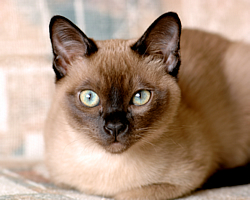|
The Scratching Post
Tonkinese 
The Tonkinese has the best features of the Siamese and the Burmese, with none of the less favorable features. The Tonkinese is a muscular, medium-sized cat. The head is wider than that of the Siamese, but narrower than the Burmese's. It has a slightly rounded wedge, which is longer than it is wide. The ears are medium-sized with rounded tips. The eyes are almond shaped and slanted along the cheekbones and are blue-green in color. The legs are muscular and the hind legs are slightly longer than the forelegs. The coat is short, silky and very shiny. It has dark points, like the Siamese, but the base color is darker than the traditional Siamese. It is close to the original Burmese color. Tonks are born white with their point colors forming within a few days. They become darker as they get older.
|
|
Temperament
|
Be prepared to be wrapped around your Tonk?s velvety paw. Tonks are gentle creatures that get along well with children, making it a great family pet. They are quite affectionate and enjoy socializing with adults, children and other animals. They hate solitude and do not attach themselves to only one family member as the Siamese and Burmese do. But like the Siamese and Burmese, they have a very loud and distinctive voice. After a good play session, Tonks enjoy dozing on or next to their humans. If you want a loving lap cat, the Tonkinese is for you!
|
|
Weight
|
Male: 9-12 lbs.; Female: 6-8 lbs.
|
|
Health Problems
|
Tonkinese kittens are susceptible to respiratory disease. Adult Tonks can be prone to plaque buildup, tartar formation and gingivitis, which can lead to the dental disease, periodonitis. Annual dental check-ups and teeth cleaning are necessary for your cat?s health.
|
|
Living Conditions
|
This breed needs plenty of room to romp, run and play. Though they enjoy being outdoors, they sometimes tend to run off, so be careful when letting them outside. Make sure screens and doors are secure also.
|
|
Exercise
|
Tonks are an active breed that needs a place to exercise outside, or ample room to romp and run indoors. They should also be provided with a scratching post and toys inside to keep them occupied.
|
|
Life Expectancy
|
15 or more years
|
|
Grooming
|
Tonks need minimum grooming and do fine with a weekly brushing of their coat as well as a gentle brushing of their teeth. Clip their nails weekly also.
|
|
Origin
|
This breed was the first intentionally bred in the US in the 1950?s by Milan Greer and another American feline expert. He crossed a male Burmese with a female chocolate-point Siamese and named the resulting breed the Golden Siamese. When he passed on the breeding project to Edith Lux, she changed the name to Tonkinese, after the Gulf of Tonkin, which is close to Burmese and Siamese (Thai) territories. The Tonk was recognized by the CFA in 1978.
|